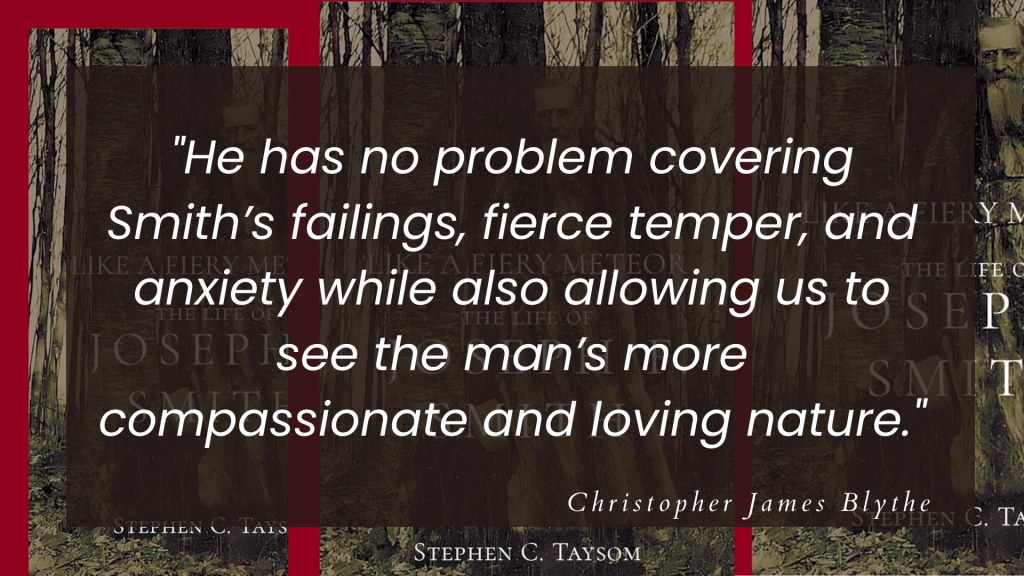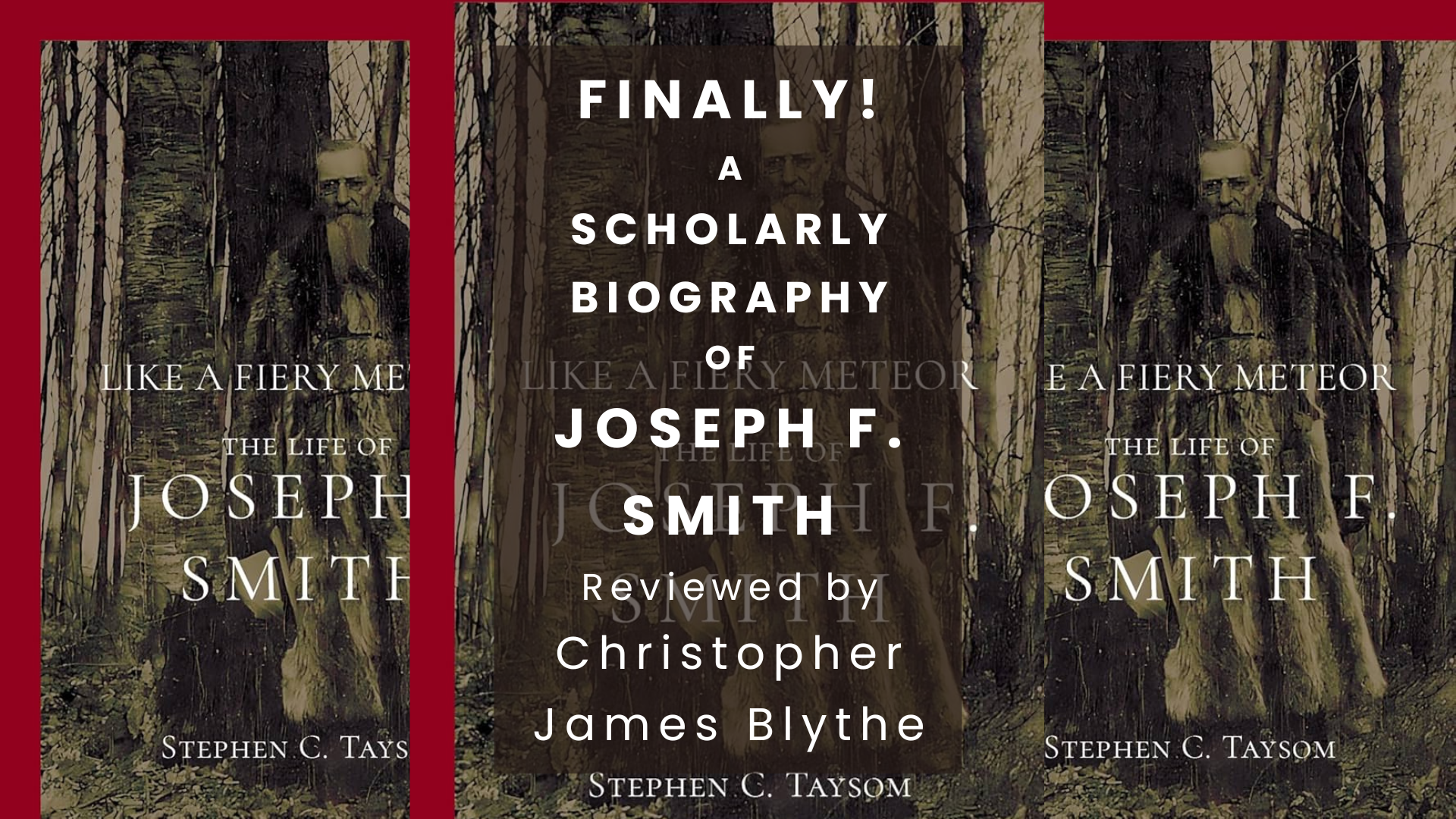Articles/Essays – Volume 57, No. 04
Finally! A Scholarly Biography of Joseph F. Smith | Stephen C. Taysom, Like a Fiery Meteor:The Life of Joseph F. Smith
In the summer of 2009, as a master’s student, I sat in one of the Neal A. Maxwell Institute’s summer seminars when the topic turned to the absence of a biography on Joseph F. Smith. I listened to Terryl Givens pontificate on the importance of this understudied figure and the significance of his presidency in the period of transition. An end of an era. One of my colleagues, Joseph Spencer, suggested that the groundwork for such a study had been established in Jan Shipps’s masterful 1985 work, Mormonism: The Story of a New Religious Tradition (Illinois). It was a memorable discussion and one I have had many times since. The LDS academic community has long been aware that we needed a biography of Joseph F. Smith. Steve Taysom took up the task several years ago, and we finally have the fruits of his labor. I’m not disappointed.
Joseph F. Smith lived a fascinating life. He was the son of the martyred Hyrum Smith and served mission after mission. Smith had multiple marriages and many children. He was pulled into the apostleship as a counselor to Brigham Young when he was not yet thirty. And, of course, he would eventually become the Prophet, Seer, and Revelator of the Church of Jesus Christ of Latter-day Saints—a position he would hold for seventeen years. It was under Smith’s presidency that we saw the Reed Smoot hearing, the second manifesto that put a final end to Church—supported plural marriage, the First World War, and the planning of the Hawaiian temple. Even if you did not find Smith’s personal life of interest, the events surrounding him are key to our understanding of the development of the modern LDS Church.

If you have paid even the most casual attention to the buzz surrounding this biography, you know that the most noteworthy discovery pertains to Joseph F. Smith’s tendency toward violence. Joseph F. Smith was not kind to his first wife, Levira, and reading the details of their relationship is painful. The marriage was doomed. Levira suffered from mental illness and infertility, while Joseph F. Smith was physically distant due to numerous missions. Smith accused Levira of infidelity and said nearly unforgiveable things about her mental illness. Ultimately, on one occasion, he beat her with a switch. It is in this moment that I realized the quality of Taysom’s biographical craft. He couched this incident from both viewpoints and then contextualized it into perspectives on domestic discipline (we’d call it abuse) in nineteenth-century America. He has no problem covering Smith’s failings, fierce temper, and anxiety while also allowing us to see the man’s more compassionate and loving nature. Taysom’s writing surrounding Smith’s reactions to the deaths of his children were particularly powerful for me.
Taysom is a relentless researcher. I am very impressed with his ability to dive into the sources and bring out such compelling material. At the same time, I think there should have been a more generous citation of previous scholarship. In the handling of postmanifesto plural marriage, I would have expected some reference to B. Carmon Hardy’s Solemn Covenant (Illinois, 1992). I don’t think we should write about depictions of Joseph F. Smith in contemporary newspapers without some acknowledgement of Paul Reeve’s Religion of a Different Color (Oxford, 2015). I was particularly surprised to see no reference to Jan Shipps’s Mormonism. As I note above, Shipps was likely the first to recognize just what a turning point Joseph F. Smith’s presidency was in LDS history. When writing about Joseph F. Smith’s 1918 revelation that would become section 138 of the Doctrine and Covenants, Taysom notes that multiple scholars have interpreted this revelation in the context of Joseph F. Smith’s son’s death and World War I, but for some reason we don’t find out who these scholars are. In truth, I was surprised to find no evidence Taysom had consulted my own work, which would have added substance to his discussion of Joseph F. Smith’s reactions to the idea of the One Mighty and Strong and, more importantly, Joseph F. Smith’s apocalypticism and reimagining of Zion in World War I.
Despite this criticism, Like a Fiery Meteor is one of the strongest titles published in 2023 in LDS studies. It is an original piece of scholarship that outshines previous studies of Joseph F. Smith—there is no question. Yet, like all such works, it is the product of the accrual of knowledge in the LDS studies community and that fact should be recognized.
The biography follows a chronological framework, covering different eras as distinct moments. Taysom acknowledges at the outset that some readers would prefer to read a thematic study of Joseph F. Smith’s life with chapters covering different themes, rather than a chronological study of his life. Yet, the chronological organization works quite nicely. Taysom leads us through the ups and downs of a life while helping us better understand major moments in LDS history. I would place Like a Fiery Meteor alongside the best LDS biographies. It deserves the same recognition in LDS historiography as such pathbreaking works as Val Avery’s From Mission to Madness: Last Son of the Mormon Prophet (Illinois, 1998), John Turner’s Brigham Young: Pioneer Prophet (Harvard, 2012), and Terryl Givens and Matthew Grow’s Parley P. Pratt: The Apostle Paul of Mormonism (Oxford, 2011). I suspect that I will return to this book many times in the years ahead.
Stephen C. Taysom. Like a Fiery Meteor: The Life of Joseph F. Smith. Salt Lake City: University of Utah Press, 2023. 445 pp. + xvi. $34.95. ISBN: 978-1-64769-128-8.


 Back to full Issue
Back to full Issue

